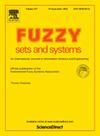Asymmetry of copulas with a given opposite diagonal section
IF 2.7
1区 数学
Q2 COMPUTER SCIENCE, THEORY & METHODS
引用次数: 0
Abstract
In this paper we investigate bivariate copulas with a given opposite diagonal section. We determine the exact lower bound for all such copulas and derive an explicit formula for the maximal asymmetry for copulas with a given opposite diagonal section. As a special case, we consider the situation when the opposite diagonal section is symmetric and unimodal, which is true in many applications. To obtain our results, we also calculate the maximal asymmetry of all distributions with fixed marginals, which is an interesting result by itself.
具有给定对角截面的连轴的不对称性
本文研究了具有对角截面的二元copula。我们确定了所有这类连的确切下界,并推导出具有给定对角截面的连的最大不对称的显式公式。作为一种特殊情况,我们考虑了对角截面对称且单峰的情况,这在许多应用中都是成立的。为了得到我们的结果,我们还计算了所有固定边际分布的最大不对称性,这本身就是一个有趣的结果。
本文章由计算机程序翻译,如有差异,请以英文原文为准。
求助全文
约1分钟内获得全文
求助全文
来源期刊

Fuzzy Sets and Systems
数学-计算机:理论方法
CiteScore
6.50
自引率
17.90%
发文量
321
审稿时长
6.1 months
期刊介绍:
Since its launching in 1978, the journal Fuzzy Sets and Systems has been devoted to the international advancement of the theory and application of fuzzy sets and systems. The theory of fuzzy sets now encompasses a well organized corpus of basic notions including (and not restricted to) aggregation operations, a generalized theory of relations, specific measures of information content, a calculus of fuzzy numbers. Fuzzy sets are also the cornerstone of a non-additive uncertainty theory, namely possibility theory, and of a versatile tool for both linguistic and numerical modeling: fuzzy rule-based systems. Numerous works now combine fuzzy concepts with other scientific disciplines as well as modern technologies.
In mathematics fuzzy sets have triggered new research topics in connection with category theory, topology, algebra, analysis. Fuzzy sets are also part of a recent trend in the study of generalized measures and integrals, and are combined with statistical methods. Furthermore, fuzzy sets have strong logical underpinnings in the tradition of many-valued logics.
 求助内容:
求助内容: 应助结果提醒方式:
应助结果提醒方式:


